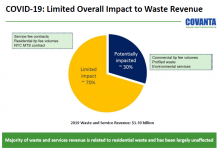by Debra Fiakas CFA
Sometime back Poet, LLC, the private producer of ethanol based in Sioux Falls, SD (my home state), filed a lawsuit against the State of California, strenuously objecting to rules related to ‘carbon intensity’ adopted by the California Air Resources Board (CARB) When the dust settled, the California rules were still standing and Poet skulked off to the appeals court. The appeal was filed this week in the California’s Fifth Appellate District in Fresno.
Originally approved in 2009, California’s ‘low carbon fuel standard’ (LCFS) is aimed at sorting apples and oranges in the renewable transportation fuels market by requiring that producers meet an average declining standard of carbon intensity. Now they must reduce total carbon measure by 10% over the next seven years. Carbon intensity is measured as the sum of all greenhouse gas emissions associated with the production, transportation, processing and consumption of a fuel. CARB calls this a ‘pathway’. More about pathways later.
Ethanol is at a disadvantage all around because it cannot be distributed through existing fuel pipelines. It must be sent by rail or truck tanker to end-markets, adding to the carbon intensity. What is more, ethanol fuels produced out-of-state end up classified lower than in-state product because the added transport element contributes even more to carbon intensity
It is understandable why Poet has its corporate hackles up over the California rules. California is the largest ethanol market in the U.S. The largest ethanol producers need to command a share. Only Archer Daniels Midland (ADM: NYSE) producers more ethanol than Poet. Poet is not alone in its efforts to fight state bureaucrats. The Renewable Fuels Association and Growth Energy also filed suit against California over the low carbon fuels standard.
Investors should also note that Poet is not arguing against the underlying principal of CARB’s LCSF. Poet has told court that CARB failed to adequately assess the environmental impact of the standard before it was adopted.
The California Air Resources Board (CARB) is a group to watch in the renewable fuel industry. They like it that way. CARB was set up in 1967 by then Governor Ronald Regan. It is a one-of-a-kind group, established before the federal government took over air quality standard setting for the country through a 1970 amendment to Clean Air Act. Now the other forty-nine states are stuck with using CARB rules or federal rules.
CARB is not in the least intimidated by Poet’s arguments against the standard. Earlier this year several parties with interests in the renewable fuel market weighed in to support CARB and its LCSF. Natural gas supplier Clean Energy Fuels Corp. (CLNE: Nasdaq) and California’s leading electric utility Pacific Gas & Electric (PCG: NYSE) as well as the California Biodiesel Alliance and the National Biodiesel Board all filed briefs with the court extolling the virtues of CARB and its LCSF. The briefs made note of California’s nascent cap-and-trade program, which sets California out ahead of the rest of the country.
Of course, these folks have a different view on California’s carbon intensity standard because it shifts the competitive balance in their favor. Renewable diesel and algal-based fuels, for example, are so-called ‘drop-in’ fuels that can be distributed using the existing pipeline infrastructure. These fuels come out looking good in the carbon intensity competition, even the producers from outside California.
So it is the ethanol industry against the renewable fuel industry. What appears to be a blow to ADM and Poet may end up being a boon to others.
Companies that might benefit include Sapphire Energy, which produces an algal-based renewable diesel. In March 2013 Sapphire landed an off-take agreement with oil refiner Tesoro Corp. (TSO: NYSE). Tesoro is buying an undisclosed amount of algal-based oil produced at Sapphire’s New Mexico plant. Sapphire claims its plant has been producing two barrels of oil per day, but could ramp to 100 barrels per day. Tesoro has reportedly agreed to take all production as the facility ramps to capacity. The EPA still has not approved Sapphire’s fuel for on-road use.
Algal-based biofuel releases the same amount of carbon dioxide that was used to grow it. This is about half the carbon dioxide released by burning gasoline. However, when the carbon dioxide used to grow algae comes from power plant or other emissions, the carbon intensity is lowered. Investors should note that there are a number of algal-based fuel producers in California. The Algae Biomass Organization recently updated a U.S. map showing locations across the country
CARB has a table of carbon intensity ‘pathways’ for various fuels. The table is to be used as guidance for all parties targeting the renewable fuel market in California. CARB has invited renewable fuel producers to apply for new pathways. With the competitive field tilted toward renewable diesel, it is not surprising that the market is attracting the interest of some big players. Indeed, oil refining giant Neste Oil (NEF: F) has applied for a ‘pathway’ or carbon intensity measure for its non-ester renewable diesel product it calls NExBTL. Neste’s Singapore plant produces about 250 million gallons of it per year from Australian tallow.
Debra Fiakas is the Managing Director of Crystal Equity Research, an alternative research resource on small capitalization companies in selected industries.
Neither the author of the Small Cap Strategist web log, Crystal Equity Research nor its affiliates have a beneficial interest in the companies mentioned herein.








